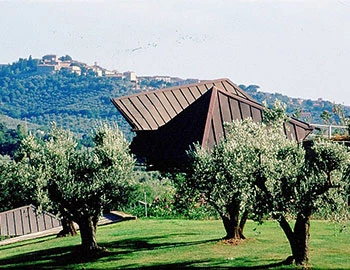San Paolo, Verdicchio dei Castelli di Jesi 2019
Classico Riserva DOCG, Pievalta, 750 ml

| Grape variety: | Verdicchio |
| Producer: | Pievalta |
| Origin: | Italy / Marche / Castelli di Jesi |
Description
San Paolo - a Verdicchio from the homonymous vineyard of the municipality of San Paolo, grown on the right bank of the Esino. It is considered one of the most suitable vineyards for Verdicchio in the Castelli di Jesi region. The symbol that adorns the label means summer and is intended to express the sunniest and brightest Verdicchio in Pievalta. A soft scent of honeycomb, apple peel, white pepper and warm straw seduce the nose and invite to the first sip. The palate is enveloped in a composition of lemongrass, granny smith, salty minerality and lemon balm. An interplay of creamy and at the same time fresh texture forms the tension arch.
Attributes
| Origin: | Italy / Marche / Castelli di Jesi |
| Grape variety: | Verdicchio |
| Label: | Vegan, Certified organic or biodynamic wine |
| Ripening potential: | 1 to 8 years |
| Drinking temperature: | 12 to 13 °C |
| Food Pairing: | Grilled fish, Smoked fish, Succulent chicken breast with cream sauc, Saltimbocca, Scaloppine di vitello al limone, Salad with vegetables, pulses, pasta |
| Vinification: | soft pressing, fermentation in steel tank |
| Maturation: | in steel tank, on the yeast |
| Bottling: | filtration |
| Maturation duration: | 18 months |
| Volume: | 13.5 % |
| Note: | Contains sulphites |
Pievalta
The Pievalta estate is located in the municipality of Maiolati Spontini, in the Marche region, in the heart of the Castelli di Jesi. This area is famous for its small fortified medieval villages as well as for the production of wines made from the Verdicchio grape.
Silvano Brescianini, the manager of the Barone Pizzini winery (Franciacorta region), founded the Pievalta winery in 2002. Already at that time, he saw the great potential of the Verdicchio grape variety. Establishing and operating a vineyard outside its own appellation seemed to him the obvious and logical step to take.
He then turned to the young Milanese oenologist Alessandro Fenino who had previously helped him for a few years on this estate in Lombardy; he was the right man to set up a new winery, immediately setting himself to an in-depth analysis of the Verdicchio grape. Fenino had been cultivating the existing vineyards organically since 2003 - that is, since the beginning - the first certified vintage being that of 2006. As early as 2005, he also adopted biodynamic viticulture and in 2008, he presented the first certified Demeter vintage. Since 2018, all wines carry the certified label "Biodyvin" instead of Demeter.

Verdicchio
The white wine star from the Marches
This very old white grape variety was originally native from northern Italy, in Venice. Her new home are the Marches, where she produces great white wines, mainly dry and sparkling. Verdicchio is very widespread in Italy. They are mainly found under one of the many synonyms such as: Angelica, Lugana, Pevarise, Pfefferer, Terbiana, Turviana, Verdone and many more. It is not related to the Spanish grape variety Verdejo or to the Portuguese Verdelho, even if the names sound similar. Its origin dates back to the Etruscan era, when it also played an important role in the conquest of Rome.
Verdicchio is a grape variety with medium to late ripening, also vulnerable to botrytis (noble rot) and therefore suitable for the production of sweet wines. It translates into fresh white wines with an ageing potential. Hence, through its emphasis on acidity, it also suits for the production of sparkling wines. Typical aromas are citrus fruits, peaches, bitter almonds and apples, combined with a mineral and salty touch.
Today, the cultivated area in Italy is about 3,530 hectares. Verdicchio is also grown in small quantities in Argentina, Brazil and California.
Italy
Italy – Where wine is a way of life
The Italian wine regions are extremely diverse, and this is made clear in their wines. Established varieties such as Merlot, Syrah, and Sauvignon can be found on just 15 percent of the total vine growing area. The remaining 85 percent is reserved for autochthonous, indigenous varieties. More than 2,000 different grape varieties are grown under diverse conditions and pressed with various techniques into wines that reach the top tier of the international wine market.



